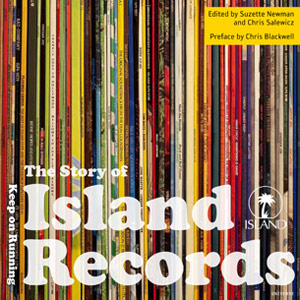
by Suzette Newman and Chris Salewicz
Universe
Depending on when you became acquainted with the label, you may associate Island Records with one of countless artists—Traffic, Bob Marley, U2, etc. However you may have become acquainted with the label, though, it’s a little saddening that the imprint is now just another meaningless brand amongst Universal’s many holdings, shelling the likes of Justin Bieber to the masses.
But until 1997, when founder Chris Blackwell stepped down as CEO (a position he had retained even after selling Island to PolyGram in 1989), the label had retained an adventurous spirit. It was that spirit, coupled with Blackwell’s industry smarts and intuitive tastes, that had led to countless successes. In many ways, Island was the last of the old breed of record labels, one run by music lovers and not bean counters, and one willing (and having the clout) to nurture and develop the artists in which it believed. Acts like U2, Tom Waits and PJ Harvey were not overnight sensations, but have since become respected luminaries while also selling records. It’s doubtful that the same will ever be said of Ludo or School Gyrls.
Keep on Running: The Story of Island Records, a new book edited by Suzette Newman and Chris Salewicx and released in time to honor the label’s 50th anniversary, takes an astute look at Island’s storied history. The book begins with a preface from Blackwell and a quick telling of the time he was rescued by a Rastafarian from dying in Jamaica’s swamps. In 1959, Blackwell released an album by Jamaican jazz pianist Lance Howard, before scoring a hit with “Boogie in My Bones” by Laurel Aitken. After working as a production assistant on Dr. No, Blackwell moved to the UK and began releasing Jamaican dancehall singles under the Island moniker as well as invented imprints like Black Swan. The records sold well in both Jamaica and in the UK.
Island would grow throughout the ’60s, eventually heading in a more “progressive” direction as it scored hits with Traffic and King Crimson. Blackwell brought other labels into the fold to distribute, widening the breadth of their catalog with new styles and acts. However, in the ’70s, Blackwell returned to his Jamaican roots, releasing The Harder They Come soundtrack and signing soon to be reggae legends like the Wailers, Lee Perry, Burning Spear, and Toots and the Maytals. The label’s roster would grow even more diverse in the coming years, but no less impressive, with artists like Grace Jones, King Sunny Ade, Pulp, and many, many others signing on.
With about a dozen writers—from NME scribe Paul Morely to record producer Joe Boyd—contributing to the book, the writing in Keep on Running varies in quality. At its best, there is insightful commentary on what was going on in the world of music and how Island fit into it, while elsewhere it falls a bit flat by merely recounting what records the label was releasing. Still, there is an overwhelming abundance of anecdotes and information, and visually the 9.5-inch squared book is filled with numerous photographs of the bands on the label and a wealth of album imagery, including iconic covers like King Crimson’s In the Court of the Crimson King and Free’s self-titled album. With it laid out in front of you, it’s hard to understand why anyone wouldn’t try to keep such a legacy alive. But then, even the idea of a record label may be antiquated in the near future, so it’s doubly worthy to have such a history preserved here.
Stephen Slaybaugh
Neil Hamburger, Hot February Night
Clinic Live Review
Devo Live Review
Rush, Beyond the Lighted Stage
Pitchfork Music Fest '10 Wrap-Up
Here Comes Your Weekend Parking Lot Blowout Live Review
Tristan Perich, 1-Bit Symphony
Touch and Go: The Complete Hardcore Punk Zine '79-'83
A Live Evening with MGMT
The World Cup Top 10
Five Hundred 45s
Jello Biafra and the Guantanamo School of Medicine and Chrome Cranks Live Reviews
David Cross, Bigger and Blackerer
Rock 'n' Roll High School
